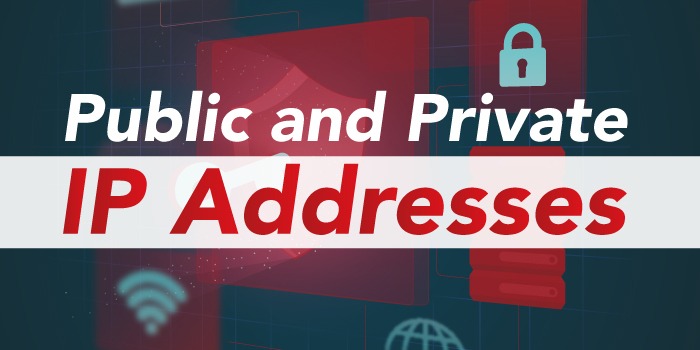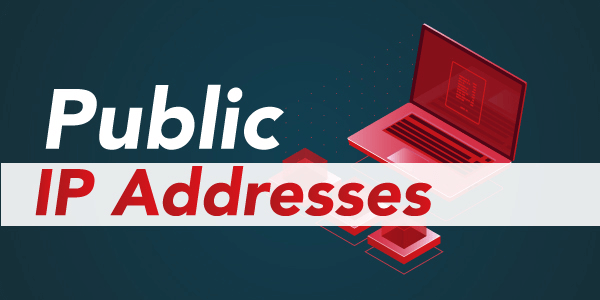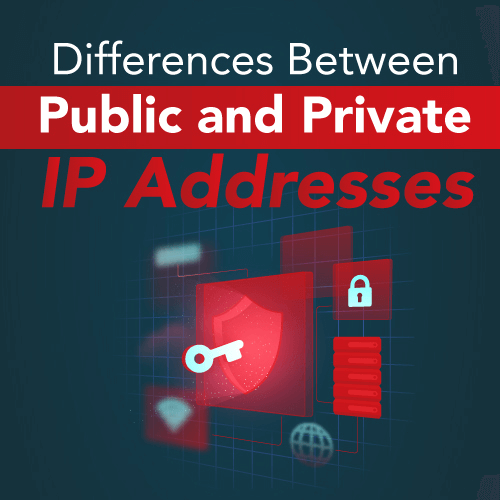![]()

April 9, 2023
Public and Private IP Addresses – All you need to Know!
With the emerging world of IOT (Internet Of Things), internet connectivity became essential for individuals and businesses alike. This connectivity is made possible by a complex network of interconnected devices that communicate with each other using unique IP addresses. The two types of addresses that are commonly used are public and private IP addresses. In this blog, we will explore what they are, how they work, and their differences.
What is an IP Address?
An internet protocol or (IP) address is a unique identifier assigned to devices that connect to the internet. It comprises a series of numbers separated by dots, e.g., 192.168.0.1. There are two main versions of IP addresses; IPv4, and IPv6 which were invented to overcome the global exhaustion problem of IPv4. Internet Protocol addresses help devices communicate with each other, and without them, the Internet as we know it wouldn’t exist.
Public IP Addresses

A public IP address is a unique identifying address assigned to a device directly connected to the internet. It can be accessed globally and represents the device’s location on the internet, like a virtual street address. Public IP addresses are managed globally by an organization called Internet Assigned Numbers Authority (IANA) which delegates to regional internet registries. Web servers, internet routers, and other devices that are directly connected to the internet are examples of devices that have public IP addresses.
Internet Service Providers (ISPs) or hosting providers assign public IP addresses to devices, and they can change over time.
Public IP addresses can be static or dynamic. Dynamic IP addresses are temporary and change each time you connect to the internet. However, you can still access the internet while using a dynamic IP address since the device’s previous IP address is replaced with a new one each time you reconnect to the internet.
On the other hand, static IP addresses are permanent and are assigned to a device by the ISP. This address does not change over time and remains the same each time you connect to the internet. Static IP addresses are mostly used by businesses that need accessible remote access to services like a VPN, servers or VOIP.
Private IP Addresses
Contrary to public IP addresses, private IP addresses are only used within a local network, usually located within homes, businesses or organizations. These types of IP addresses are not visible on the public internet, so they don’t have the unique addressability that public IPs have. This means that devices with private IP addresses cannot be accessed from outside the local network.
Private IP addresses are used to create a unique identity for each device within a network. Doing this makes it possible for different devices within the same network to communicate with each other without interference from outside connections. Private IP addresses are typically issued by a router located within the same network as each connected device.
What are the 3 Private IP Address Ranges?
The ranges of private IP addresses are defined by the Internet Engineering Task Force (IETF) and comprise three major ranges:
- 10.0.0.0 to 10.255.255.255
- 172.16.0.0 to 172.31.255.255
- 192.168.0.0 to 192.168.255.255
Private IP addresses help devices connect to the internet indirectly through the router, which assigns each device a unique local IP address that is unique within the network. Therefore, private IP addresses are not considered Internet Protocol (IP) addresses but rather are intranet addresses.
The Main Differences Between Public and Private IP Addresses

Accessibility
One of the primary differences between public and private IP addresses is that public IP addresses are accessible from the internet, while private IP addresses are accessible only through their own private network.
Uniqueness
Private IP addresses are not globally unique and can be reused on different private networks as they are only visible on a specific network. However, public IP addresses are globally unique and cannot be reused.
Providers
The other difference is that public IP addresses are provided by internet service providers, while private IP addresses are assigned by a local network.
Address Ranges
Private IP addresses are assigned from specific address ranges, such as 10.0.0.0/8, 172.16.0.0/12, and 192.168.0.0/16. In contrast, public IP addresses can be assigned from any available range.
NAT
Network Address Translation (NAT) is a technique used to translate private IP addresses to public IP addresses and vice versa. Private IP addresses are translated to a public IP address when sending data to the Internet, and the public IP address is translated to a private IP address when receiving data from the Internet. NAT allows multiple devices on a private network to share a single public IP address.
In conclusion, both public and private IP addresses play an essential role in Internet communication. That’s why understanding the differences between these two types of IPs is vital for any person or business that seeks to establish and maintain its network.
Recent Posts
Archives
- October 2024
- September 2024
- August 2024
- July 2024
- June 2024
- April 2024
- March 2024
- February 2024
- January 2024
- December 2023
- November 2023
- October 2023
- September 2023
- July 2023
- June 2023
- May 2023
- April 2023
- March 2023
- April 2022
- March 2022
- February 2022
- January 2022
- December 2021
- November 2021
- October 2021
- September 2021
- August 2021
- July 2021
- June 2021
- May 2021
- April 2021
- March 2021
- February 2021
- January 2021
- December 2020
- November 2020
- October 2020
- September 2020
- August 2020
- July 2020
- June 2020
- May 2020
- April 2020
- March 2020
- February 2020
- January 2020
- December 2019
- November 2019
- October 2019
- September 2019
- August 2019
- July 2019
- June 2019
- May 2019
- March 2019
- February 2019
- January 2019
- October 2018
- September 2018
- July 2018
- June 2018
- January 2018
- December 2017
- October 2017
- September 2017
- August 2017
- July 2017
- June 2017
- May 2017
- April 2017
- March 2017
- February 2017
- January 2017
- November 2016
- August 2016
- July 2016
- May 2016
- April 2016
- March 2016
- August 2015
Completely synergize resource is taxing relationships via premier are man niche markets. Professionally cultivate one to one customer.
Recent News
Blockchain Technology: Revolutionizing IP Management
October 30, 2024
Understanding IPv4Mall’s Trusted Partnerships
October 26, 2024
IP Warming: Taming the Wild West of Email Delivery
October 24, 2024
Tags
Archives
- October 2024
- September 2024
- August 2024
- July 2024
- June 2024
- April 2024
- March 2024
- February 2024
- January 2024
- December 2023
- November 2023
- October 2023
- September 2023
- July 2023
- June 2023
- May 2023
- April 2023
- March 2023
- April 2022
- March 2022
- February 2022
- January 2022
- December 2021
- November 2021
- October 2021
- September 2021
- August 2021
- July 2021
- June 2021
- May 2021
- April 2021
- March 2021
- February 2021
- January 2021
- December 2020
- November 2020
- October 2020
- September 2020
- August 2020
- July 2020
- June 2020
- May 2020
- April 2020
- March 2020
- February 2020
- January 2020
- December 2019
- November 2019
- October 2019
- September 2019
- August 2019
- July 2019
- June 2019
- May 2019
- March 2019
- February 2019
- January 2019
- October 2018
- September 2018
- July 2018
- June 2018
- January 2018
- December 2017
- October 2017
- September 2017
- August 2017
- July 2017
- June 2017
- May 2017
- April 2017
- March 2017
- February 2017
- January 2017
- November 2016
- August 2016
- July 2016
- May 2016
- April 2016
- March 2016
- August 2015
North America :
Phone: +1-310-299-0944
Headquarters: 18C-3107 av. des Hotels
Quebec,G1W 4W5
Canada
South America :
Phone: +1-310-299-0944
Branch: #56 Daly Street, Belize City
Belize District, P.O. Box 1825
Belize











Recent Comments